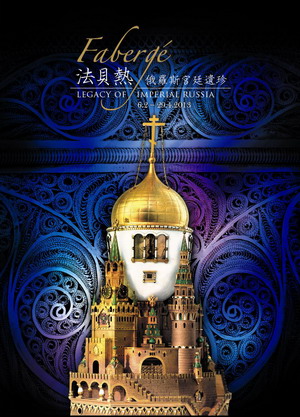|
Fabergé: Legacy of Imperial Russia
Thematic Galleries (1) and (2),
Hong Kong Heritage Museum 06 February 2013 - 29 April 2013
 'Fabergé: Legacy of Imperial Russia' Special Website Presented by the Leisure and Cultural Services Department Jointly organized by the Hong Kong Heritage Museum, the Moscow Kremlin Museums and the Fersman Mineralogical Museum A master jeweller and goldsmith, Peter Carl Fabergé (1846-1920) was a leading figure in the rise of Russian jewellery craftsmanship in the late 19th century. Although the fame of the House of Fabergé faded for a while following the outbreak of the Russian Revolution, its worldwide renown persisted thanks to the fabulous masterpieces that it produced. Of the numerous items that the House of Fabergé created for the Russian court, its Imperial Easter eggs are undoubtedly its most spectacular works: designed as an Easter surprise for the royal family, they continue to amaze us even today. The Fabergé Easter eggs on display are undoubtedly the highlight of this exhibition, but they are accompanied by many other rare and exceptional artworks and pieces of jewellery in a variety of precious metals and stones that bear witness to the fine craftsmanship of the former Russian Empire, while also offering visitors a chance to learn more about the illustrious history of the House of Fabergé. The exhibits, numbering over 200 in total, are on loan from the collections of the Moscow Kremlin Museums and the Fersman Mineralogical Museum of Russia. Introduction The exhibition features the achievements of the jewellery industry of Russia from the 19th to the 20th centuries, and Peter Carl Fabergé (1846-1920) is the most successful jeweller of the period. The success of Fabergé stemmed from his dedication to innovate and open mind to combine and embrace the craftsmanship and techniques from different forms and artistic styles. This exhibition will be divided into three sections, including the "History of Fabergé", "A Glimpse of Imperial Russia" and "Representation of Beauty" to feature the achievements of craftsmanship of the Russian jewellery industry. The first section of the exhibition will introduce Fabergé and his jewellery empire. The second section will introduce the close relationship between Fabergé and the royal family of the last two Tsars of the Romanov dynasty. On display in this section are four Fabergé Easter eggs, the highlights of this exhibition, along with other artworks that used to belong to the last two tsars of the Romanov dynasty as well as their family members, together with art works produced by the jewellers ordered by the Russian imperial court as official gifts to subjects and foreigners. The third section will focus on the ecclesiastical objects, treasures of the commoners including silverwares as well as jewellery adornments. Documentary During the exhibition period, a documentary "Mosaic of Memories" (2011) will be on show in Orientation Theatre at ground floor of the museum. Carl Fabergé devoted his life into establishing his own highly acclaimed jewellery empire. Yet, the morning sun never lasts long. The end of the Russian dynasty also led to the decline of the Fabergé jewellery empire. This documentary depicts the art of Carl Fabergé as well as the rise and fall of the House of Fabergé. Language: Russian Subtitle: English Duration: approx. 25 mins. Admission Fee
|
||||||||||||||||||||||||||